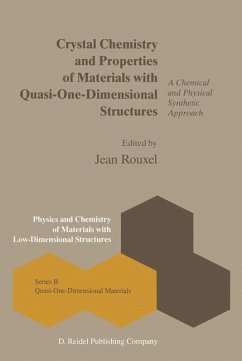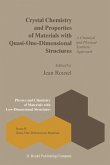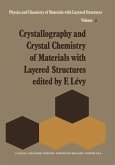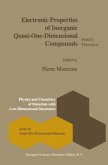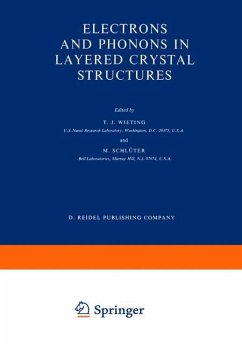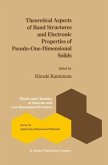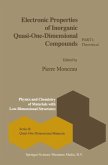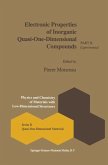Crystal Chemistry and Properties of Materials with Quasi-One-Dimensional Structures
A Chemical and Physical Synthetic Approach
Herausgegeben:Rouxel, J.
Crystal Chemistry and Properties of Materials with Quasi-One-Dimensional Structures
A Chemical and Physical Synthetic Approach
Herausgegeben:Rouxel, J.
- Broschiertes Buch
- Merkliste
- Auf die Merkliste
- Bewerten Bewerten
- Teilen
- Produkt teilen
- Produkterinnerung
- Produkterinnerung
There is no doubt that in the development of the Physics and Chemistry of Solids during the last fifteen years, the very important place taken by low-dimensional compounds will be remembered as a major event. Dealing very widely at the beginning with two-dimensional structures and intercalation chemistry, this theme progressively evolved as the synthesis of one-dimensional conductors increased, along with the observation of their remarkable properties. Beyond the classical separation of the traditional disciplines, essential progress has stemmed each time from the concerted efforts of, and…mehr
Andere Kunden interessierten sich auch für
![Crystal Chemistry and Properties of Materials with Quasi-One-Dimensional Structures Crystal Chemistry and Properties of Materials with Quasi-One-Dimensional Structures]() J. Rouxel (Hrsg.)Crystal Chemistry and Properties of Materials with Quasi-One-Dimensional Structures161,99 €
J. Rouxel (Hrsg.)Crystal Chemistry and Properties of Materials with Quasi-One-Dimensional Structures161,99 €![Crystallography and Crystal Chemistry of Materials with Layered Structures Crystallography and Crystal Chemistry of Materials with Layered Structures]() Crystallography and Crystal Chemistry of Materials with Layered Structures41,99 €
Crystallography and Crystal Chemistry of Materials with Layered Structures41,99 €![Electronic Properties of Inorganic Quasi-One-Dimensional Compounds Electronic Properties of Inorganic Quasi-One-Dimensional Compounds]() Electronic Properties of Inorganic Quasi-One-Dimensional Compounds121,99 €
Electronic Properties of Inorganic Quasi-One-Dimensional Compounds121,99 €![Electrons and Phonons in Layered Crystal Structures Electrons and Phonons in Layered Crystal Structures]() Electrons and Phonons in Layered Crystal Structures41,99 €
Electrons and Phonons in Layered Crystal Structures41,99 €![Theoretical Aspects of Band Structures and Electronic Properties of Pseudo-One-Dimensional Solids Theoretical Aspects of Band Structures and Electronic Properties of Pseudo-One-Dimensional Solids]() Theoretical Aspects of Band Structures and Electronic Properties of Pseudo-One-Dimensional Solids161,99 €
Theoretical Aspects of Band Structures and Electronic Properties of Pseudo-One-Dimensional Solids161,99 €![Electronic Properties of Inorganic Quasi-One-Dimensional Compounds Electronic Properties of Inorganic Quasi-One-Dimensional Compounds]() P. Monceau (Hrsg.)Electronic Properties of Inorganic Quasi-One-Dimensional Compounds121,99 €
P. Monceau (Hrsg.)Electronic Properties of Inorganic Quasi-One-Dimensional Compounds121,99 €![Electronic Properties of Inorganic Quasi-One-Dimensional Compounds Electronic Properties of Inorganic Quasi-One-Dimensional Compounds]() Electronic Properties of Inorganic Quasi-One-Dimensional Compounds161,99 €
Electronic Properties of Inorganic Quasi-One-Dimensional Compounds161,99 €-
-
-
There is no doubt that in the development of the Physics and Chemistry of Solids during the last fifteen years, the very important place taken by low-dimensional compounds will be remembered as a major event. Dealing very widely at the beginning with two-dimensional structures and intercalation chemistry, this theme progressively evolved as the synthesis of one-dimensional conductors increased, along with the observation of their remarkable properties. Beyond the classical separation of the traditional disciplines, essential progress has stemmed each time from the concerted efforts of, and overlapping between, chemists, experimental physicists, and theoreticians. This book is a synthetic approach which aims to retrace these united efforts. The observation and characterization of charge density waves in their static or dynamic aspects have been the main points to attract the interest of researchers. Two broad categories of compounds have been the material basis of these observa tions: transition-metal polychalcogenides and either condensed-cluster phases or bronze-type compounds. These families are referred to throughout the various chapters of this book, thus illustrating the continuous progress of concepts in this domain and, at the same time, providing the first synthetic and exhaustive view of this group of materials.
Hinweis: Dieser Artikel kann nur an eine deutsche Lieferadresse ausgeliefert werden.
Hinweis: Dieser Artikel kann nur an eine deutsche Lieferadresse ausgeliefert werden.
Produktdetails
- Produktdetails
- Physics and Chemistry of Materials with B 5
- Verlag: Springer Netherlands / Springer, Berlin
- Softcover reprint of the original 1st ed. 1986
- Seitenzahl: 392
- Erscheinungstermin: 12. Oktober 2011
- Englisch
- Abmessung: 235mm x 155mm x 22mm
- Gewicht: 593g
- ISBN-13: 9789401085168
- ISBN-10: 9401085161
- Artikelnr.: 39497100
- Herstellerkennzeichnung Die Herstellerinformationen sind derzeit nicht verfügbar.
- Physics and Chemistry of Materials with B 5
- Verlag: Springer Netherlands / Springer, Berlin
- Softcover reprint of the original 1st ed. 1986
- Seitenzahl: 392
- Erscheinungstermin: 12. Oktober 2011
- Englisch
- Abmessung: 235mm x 155mm x 22mm
- Gewicht: 593g
- ISBN-13: 9789401085168
- ISBN-10: 9401085161
- Artikelnr.: 39497100
- Herstellerkennzeichnung Die Herstellerinformationen sind derzeit nicht verfügbar.
An Approach to One
Dimensional Compounds.
1. Structural considerations.
2. 1D Structures for intercalation chemistry.
3. 1D Materials as conductors.
3.1. Nature and origin of instabilities.
3.2. From Krogmann's salts to NbSe3.
3.3. Charge density wave depinning.
4. Conclusion.
Orbital Interaction Analysis for the Electronic Structures of Low
Dimensional Solids.
1. Introduction.
2. Crystal structure and band orbital.
2.1. Direct and reciprocal lattice.
2.2. Band orbital formation.
3. Peierls distortion.
3.1. Band folding and splitting.
3.2. First
order Peierls distortion.
3.3. Second
order Peierls distortion.
4. Low
dimensional solids.
4.1. Structures derived from ML6 octahedra.
4.2. Structures derived from ML6 trigonal prisms.
4.3. Structures derived from ML8 tetragonal antiprisms.
5. Concluding remarks.
Structural Studies of Phase Transitions in One
Dimensional Conductors.
1. General aspects of phase transitions in condensed matter.
1.1. Thermodynamic classification.
1.2. Symmetry and order parameter.
1.3. Elements of the phenomenological Landau theory.
1.4. Fluctuations and correlations.
2. Peierls instability of a one
dimensional metal.
2.1. 2kF instability of a one
dimensional electron gas.
2.2. Charge density waves, incommensurability.
2.3. Precursor effects, Kohn anomaly.
2.4. Interchain couplings.
2.5. Beyond the independent electron picture and the mean
field treatment.
3. Representative structural studies of one
dimensional conductors.
3.1. Peierls transitions.
3.2. Anion ordering transitions in the TMTS(T)F2X series.
4. Concluding remarks.
Charge Density Wave Instability and Nonlinear Transport in the Quasi
One
Dimensional Blue Bronzes K0.30MoO3 and Rb0.30MoO3.
1. Introduction.
2. Structural aspects.
3. Ohmic transport.
4. Optical properties.
5. Specific heat and lattice dynamics.
6. Magnetic properties.
7. Band structure and the Peierls transition.
8. Nonlinear transport and related properties.
8.1. Threshold electric field.
8.2. High
frequency voltage oscillations.
8.3. Frequency
dependent conductivity.
8.4. Very low fequency phenomena.
8.5. Other metastability phenomena.
8.6. X
ray studies under electric field.
8.7. Effects of irradiation on the nonlinear properties.
8.8. Comparison between K0.30MoO3 and Rb0.30MoO3.
8.9. Discussion.
9. Conclusion.
New Transition Metal Halides and Oxides with Extended Metal
Metal Bonding.
1. Introduction.
2. Background.
3. Infinite metal chains.
3.1. Zig
zag chains and fused rhomboids.
3.2. Chains of octahedra.
3.3. Distortions in chains.
3.4. Interstitial atoms in chains.
4. Related sheet structures.
5. General correlations.
5.1. The metals and nonmetals involved.
5.2. Bonding and bond orders.
5.3. Interstitial atoms.
5.4. Other electronic factors.
6. Outlook.
Pseudo
One
Dimensional MX3 and MX4 Transition Metal Chalcogenides.
1. Trichalcogenides of iva, va, and via elements.
1.1. ZrSe3 structural type.
1.2. TaSe3 structural type.
1.3. NbSe3 structural type.
1.4. Amorphous MX3 chalcogenides.
1.5. Intercalation in trichalcogenides.
2. FeNb3Se10: a new structural type.
3. Tetrachalcogenides and related compounds.
3.1. VS4 structural type.
3.2. NbTe4 structural type.
3.3. (NbSe4)3I structural type.
4. Nb2Se9 and pentachalcogenides.
4.1. Nb2Se9.
4.2. Pentachalcogenides of group iva elements.
5. Discussion and concluding remarks.
Pentachalcogenides of Transition Metals.
1. Introduction.
2. Preparation.
3. Crystal structure.
3.1. Basic structure.
3.2. Structure modulation and polytype.
4. Transport properties and related phenomena.
4.1. Electrical resistivity.
4.2. Hall effect.
4.3. Thermoelectric power.
4.4. Mechanism of transport anomalies.
5. Band structure and Fermi surface.
5.1. Band structure calculation.
5.2. Schubnikov de Haas effect.
6. Magnetic susceptibility.
7. Raman scattering.
8. Elastic anomaly and specific heat.
8.1. Elastic anomaly.
8.2. Specific heat.
9. Pressure effect.
10. Mixed systems.
From Three
Dimensional to One
Dimensional Cluster Mo6 Chalcogenides.
1. Introduction.
2. Principle of the cluster condensation in ternary Mo
chalcogenides.
3. Metal
metal bonding approach in the Mo
cluster compounds.
4. New Ternary Mo
Chalcogenides with discrete Mo6n clusters (n finite).
4.1. Co
crystallization of Mo9X11 and Mo12X14 units with Mo6X8 units.
4.2. Crystallization of only condensed units: Mo6nX6n + 2 units.
5. Electronic properties and bond order.
5.1. Theoretical electronic properties.
5.2. Bond order.
5.3. Electronic physical properties.
6. New pseudo
one
dimensional $$({\rm Mo}_{6/2}{\rm X}_{6/2})_{\infty}^{1}$$ infinite chain.
6.1. Preparation.
6.2. Structural description.
6.3. Physical properties.
7. Conclusion.
Index of Formulas.
Index of Names.
Index of Subjects.
Dimensional Compounds.
1. Structural considerations.
2. 1D Structures for intercalation chemistry.
3. 1D Materials as conductors.
3.1. Nature and origin of instabilities.
3.2. From Krogmann's salts to NbSe3.
3.3. Charge density wave depinning.
4. Conclusion.
Orbital Interaction Analysis for the Electronic Structures of Low
Dimensional Solids.
1. Introduction.
2. Crystal structure and band orbital.
2.1. Direct and reciprocal lattice.
2.2. Band orbital formation.
3. Peierls distortion.
3.1. Band folding and splitting.
3.2. First
order Peierls distortion.
3.3. Second
order Peierls distortion.
4. Low
dimensional solids.
4.1. Structures derived from ML6 octahedra.
4.2. Structures derived from ML6 trigonal prisms.
4.3. Structures derived from ML8 tetragonal antiprisms.
5. Concluding remarks.
Structural Studies of Phase Transitions in One
Dimensional Conductors.
1. General aspects of phase transitions in condensed matter.
1.1. Thermodynamic classification.
1.2. Symmetry and order parameter.
1.3. Elements of the phenomenological Landau theory.
1.4. Fluctuations and correlations.
2. Peierls instability of a one
dimensional metal.
2.1. 2kF instability of a one
dimensional electron gas.
2.2. Charge density waves, incommensurability.
2.3. Precursor effects, Kohn anomaly.
2.4. Interchain couplings.
2.5. Beyond the independent electron picture and the mean
field treatment.
3. Representative structural studies of one
dimensional conductors.
3.1. Peierls transitions.
3.2. Anion ordering transitions in the TMTS(T)F2X series.
4. Concluding remarks.
Charge Density Wave Instability and Nonlinear Transport in the Quasi
One
Dimensional Blue Bronzes K0.30MoO3 and Rb0.30MoO3.
1. Introduction.
2. Structural aspects.
3. Ohmic transport.
4. Optical properties.
5. Specific heat and lattice dynamics.
6. Magnetic properties.
7. Band structure and the Peierls transition.
8. Nonlinear transport and related properties.
8.1. Threshold electric field.
8.2. High
frequency voltage oscillations.
8.3. Frequency
dependent conductivity.
8.4. Very low fequency phenomena.
8.5. Other metastability phenomena.
8.6. X
ray studies under electric field.
8.7. Effects of irradiation on the nonlinear properties.
8.8. Comparison between K0.30MoO3 and Rb0.30MoO3.
8.9. Discussion.
9. Conclusion.
New Transition Metal Halides and Oxides with Extended Metal
Metal Bonding.
1. Introduction.
2. Background.
3. Infinite metal chains.
3.1. Zig
zag chains and fused rhomboids.
3.2. Chains of octahedra.
3.3. Distortions in chains.
3.4. Interstitial atoms in chains.
4. Related sheet structures.
5. General correlations.
5.1. The metals and nonmetals involved.
5.2. Bonding and bond orders.
5.3. Interstitial atoms.
5.4. Other electronic factors.
6. Outlook.
Pseudo
One
Dimensional MX3 and MX4 Transition Metal Chalcogenides.
1. Trichalcogenides of iva, va, and via elements.
1.1. ZrSe3 structural type.
1.2. TaSe3 structural type.
1.3. NbSe3 structural type.
1.4. Amorphous MX3 chalcogenides.
1.5. Intercalation in trichalcogenides.
2. FeNb3Se10: a new structural type.
3. Tetrachalcogenides and related compounds.
3.1. VS4 structural type.
3.2. NbTe4 structural type.
3.3. (NbSe4)3I structural type.
4. Nb2Se9 and pentachalcogenides.
4.1. Nb2Se9.
4.2. Pentachalcogenides of group iva elements.
5. Discussion and concluding remarks.
Pentachalcogenides of Transition Metals.
1. Introduction.
2. Preparation.
3. Crystal structure.
3.1. Basic structure.
3.2. Structure modulation and polytype.
4. Transport properties and related phenomena.
4.1. Electrical resistivity.
4.2. Hall effect.
4.3. Thermoelectric power.
4.4. Mechanism of transport anomalies.
5. Band structure and Fermi surface.
5.1. Band structure calculation.
5.2. Schubnikov de Haas effect.
6. Magnetic susceptibility.
7. Raman scattering.
8. Elastic anomaly and specific heat.
8.1. Elastic anomaly.
8.2. Specific heat.
9. Pressure effect.
10. Mixed systems.
From Three
Dimensional to One
Dimensional Cluster Mo6 Chalcogenides.
1. Introduction.
2. Principle of the cluster condensation in ternary Mo
chalcogenides.
3. Metal
metal bonding approach in the Mo
cluster compounds.
4. New Ternary Mo
Chalcogenides with discrete Mo6n clusters (n finite).
4.1. Co
crystallization of Mo9X11 and Mo12X14 units with Mo6X8 units.
4.2. Crystallization of only condensed units: Mo6nX6n + 2 units.
5. Electronic properties and bond order.
5.1. Theoretical electronic properties.
5.2. Bond order.
5.3. Electronic physical properties.
6. New pseudo
one
dimensional $$({\rm Mo}_{6/2}{\rm X}_{6/2})_{\infty}^{1}$$ infinite chain.
6.1. Preparation.
6.2. Structural description.
6.3. Physical properties.
7. Conclusion.
Index of Formulas.
Index of Names.
Index of Subjects.
An Approach to One-Dimensional Compounds.- 1. Structural considerations.- 2. 1D Structures for intercalation chemistry.- 3. 1D Materials as conductors.- 4. Conclusion.- Orbital Interaction Analysis for the Electronic Structures of Low-Dimensional Solids.- 1. Introduction.- 2. Crystal structure and band orbital.- 3. Peierls distortion.- 4. Low-dimensional solids.- 5. Concluding remarks.- Structural Studies of Phase Transitions in One-Dimensional Conductors.- 1. General aspects of phase transitions in condensed matter.- 2. Peierls instability of a one-dimensional metal.- 3. Representative structural studies of one-dimensional conductors.- 4. Concluding remarks.- Charge Density Wave Instability and Nonlinear Transport in the Quasi-One-Dimensional Blue Bronzes K0.30MoO3 and Rb0.30MoO3.- 1. Introduction.- 2. Structural aspects.- 3. Ohmic transport.- 4. Optical properties.- 5. Specific heat and lattice dynamics.- 6. Magnetic properties.- 7. Band structure and the Peierls transition.- 8. Nonlinear transport and related properties.- 9. Conclusion.- New Transition Metal Halides and Oxides with Extended Metal-Metal Bonding.- 1. Introduction.- 2. Background.- 3. Infinite metal chains.- 4. Related sheet structures.- 5. General correlations.- 6. Outlook.- Pseudo-One-Dimensional MX3 and MX4 Transition Metal Chalcogenides.- 1. Trichalcogenides of iva, va, and via elements.- 2. FeNb3Se10: a new structural type.- 3. Tetrachalcogenides and related compounds.- 4. Nb2Se9 and pentachalcogenides.- 5. Discussion and concluding remarks.- Pentachalcogenides of Transition Metals.- 1. Introduction.- 2. Preparation.- 3. Crystal structure.- 4. Transport properties and related phenomena.- 5. Band structure and Fermi surface.- 6. Magnetic susceptibility.- 7. Raman scattering.- 8. Elastic anomalyand specific heat.- 9. Pressure effect.- 10. Mixed systems.- From Three-Dimensional to One-Dimensional Cluster Mo6 Chalcogenides.- 1. Introduction.- 2. Principle of the cluster condensation in ternary Mo-chalcogenides.- 3. Metal-metal bonding approach in the Mo-cluster compounds.- 4. New Ternary Mo-Chalcogenides with discrete Mo6n clusters (n finite).- 5. Electronic properties and bond order.- 6. New pseudo-one-dimensional $$({rm Mo}_{6/2}{rm X}_{6/2})_{infty}^{1}$$ infinite chain.- 7. Conclusion.- Index of Formulas.- Index of Names.- Index of Subjects.
An Approach to One
Dimensional Compounds.
1. Structural considerations.
2. 1D Structures for intercalation chemistry.
3. 1D Materials as conductors.
3.1. Nature and origin of instabilities.
3.2. From Krogmann's salts to NbSe3.
3.3. Charge density wave depinning.
4. Conclusion.
Orbital Interaction Analysis for the Electronic Structures of Low
Dimensional Solids.
1. Introduction.
2. Crystal structure and band orbital.
2.1. Direct and reciprocal lattice.
2.2. Band orbital formation.
3. Peierls distortion.
3.1. Band folding and splitting.
3.2. First
order Peierls distortion.
3.3. Second
order Peierls distortion.
4. Low
dimensional solids.
4.1. Structures derived from ML6 octahedra.
4.2. Structures derived from ML6 trigonal prisms.
4.3. Structures derived from ML8 tetragonal antiprisms.
5. Concluding remarks.
Structural Studies of Phase Transitions in One
Dimensional Conductors.
1. General aspects of phase transitions in condensed matter.
1.1. Thermodynamic classification.
1.2. Symmetry and order parameter.
1.3. Elements of the phenomenological Landau theory.
1.4. Fluctuations and correlations.
2. Peierls instability of a one
dimensional metal.
2.1. 2kF instability of a one
dimensional electron gas.
2.2. Charge density waves, incommensurability.
2.3. Precursor effects, Kohn anomaly.
2.4. Interchain couplings.
2.5. Beyond the independent electron picture and the mean
field treatment.
3. Representative structural studies of one
dimensional conductors.
3.1. Peierls transitions.
3.2. Anion ordering transitions in the TMTS(T)F2X series.
4. Concluding remarks.
Charge Density Wave Instability and Nonlinear Transport in the Quasi
One
Dimensional Blue Bronzes K0.30MoO3 and Rb0.30MoO3.
1. Introduction.
2. Structural aspects.
3. Ohmic transport.
4. Optical properties.
5. Specific heat and lattice dynamics.
6. Magnetic properties.
7. Band structure and the Peierls transition.
8. Nonlinear transport and related properties.
8.1. Threshold electric field.
8.2. High
frequency voltage oscillations.
8.3. Frequency
dependent conductivity.
8.4. Very low fequency phenomena.
8.5. Other metastability phenomena.
8.6. X
ray studies under electric field.
8.7. Effects of irradiation on the nonlinear properties.
8.8. Comparison between K0.30MoO3 and Rb0.30MoO3.
8.9. Discussion.
9. Conclusion.
New Transition Metal Halides and Oxides with Extended Metal
Metal Bonding.
1. Introduction.
2. Background.
3. Infinite metal chains.
3.1. Zig
zag chains and fused rhomboids.
3.2. Chains of octahedra.
3.3. Distortions in chains.
3.4. Interstitial atoms in chains.
4. Related sheet structures.
5. General correlations.
5.1. The metals and nonmetals involved.
5.2. Bonding and bond orders.
5.3. Interstitial atoms.
5.4. Other electronic factors.
6. Outlook.
Pseudo
One
Dimensional MX3 and MX4 Transition Metal Chalcogenides.
1. Trichalcogenides of iva, va, and via elements.
1.1. ZrSe3 structural type.
1.2. TaSe3 structural type.
1.3. NbSe3 structural type.
1.4. Amorphous MX3 chalcogenides.
1.5. Intercalation in trichalcogenides.
2. FeNb3Se10: a new structural type.
3. Tetrachalcogenides and related compounds.
3.1. VS4 structural type.
3.2. NbTe4 structural type.
3.3. (NbSe4)3I structural type.
4. Nb2Se9 and pentachalcogenides.
4.1. Nb2Se9.
4.2. Pentachalcogenides of group iva elements.
5. Discussion and concluding remarks.
Pentachalcogenides of Transition Metals.
1. Introduction.
2. Preparation.
3. Crystal structure.
3.1. Basic structure.
3.2. Structure modulation and polytype.
4. Transport properties and related phenomena.
4.1. Electrical resistivity.
4.2. Hall effect.
4.3. Thermoelectric power.
4.4. Mechanism of transport anomalies.
5. Band structure and Fermi surface.
5.1. Band structure calculation.
5.2. Schubnikov de Haas effect.
6. Magnetic susceptibility.
7. Raman scattering.
8. Elastic anomaly and specific heat.
8.1. Elastic anomaly.
8.2. Specific heat.
9. Pressure effect.
10. Mixed systems.
From Three
Dimensional to One
Dimensional Cluster Mo6 Chalcogenides.
1. Introduction.
2. Principle of the cluster condensation in ternary Mo
chalcogenides.
3. Metal
metal bonding approach in the Mo
cluster compounds.
4. New Ternary Mo
Chalcogenides with discrete Mo6n clusters (n finite).
4.1. Co
crystallization of Mo9X11 and Mo12X14 units with Mo6X8 units.
4.2. Crystallization of only condensed units: Mo6nX6n + 2 units.
5. Electronic properties and bond order.
5.1. Theoretical electronic properties.
5.2. Bond order.
5.3. Electronic physical properties.
6. New pseudo
one
dimensional $$({\rm Mo}_{6/2}{\rm X}_{6/2})_{\infty}^{1}$$ infinite chain.
6.1. Preparation.
6.2. Structural description.
6.3. Physical properties.
7. Conclusion.
Index of Formulas.
Index of Names.
Index of Subjects.
Dimensional Compounds.
1. Structural considerations.
2. 1D Structures for intercalation chemistry.
3. 1D Materials as conductors.
3.1. Nature and origin of instabilities.
3.2. From Krogmann's salts to NbSe3.
3.3. Charge density wave depinning.
4. Conclusion.
Orbital Interaction Analysis for the Electronic Structures of Low
Dimensional Solids.
1. Introduction.
2. Crystal structure and band orbital.
2.1. Direct and reciprocal lattice.
2.2. Band orbital formation.
3. Peierls distortion.
3.1. Band folding and splitting.
3.2. First
order Peierls distortion.
3.3. Second
order Peierls distortion.
4. Low
dimensional solids.
4.1. Structures derived from ML6 octahedra.
4.2. Structures derived from ML6 trigonal prisms.
4.3. Structures derived from ML8 tetragonal antiprisms.
5. Concluding remarks.
Structural Studies of Phase Transitions in One
Dimensional Conductors.
1. General aspects of phase transitions in condensed matter.
1.1. Thermodynamic classification.
1.2. Symmetry and order parameter.
1.3. Elements of the phenomenological Landau theory.
1.4. Fluctuations and correlations.
2. Peierls instability of a one
dimensional metal.
2.1. 2kF instability of a one
dimensional electron gas.
2.2. Charge density waves, incommensurability.
2.3. Precursor effects, Kohn anomaly.
2.4. Interchain couplings.
2.5. Beyond the independent electron picture and the mean
field treatment.
3. Representative structural studies of one
dimensional conductors.
3.1. Peierls transitions.
3.2. Anion ordering transitions in the TMTS(T)F2X series.
4. Concluding remarks.
Charge Density Wave Instability and Nonlinear Transport in the Quasi
One
Dimensional Blue Bronzes K0.30MoO3 and Rb0.30MoO3.
1. Introduction.
2. Structural aspects.
3. Ohmic transport.
4. Optical properties.
5. Specific heat and lattice dynamics.
6. Magnetic properties.
7. Band structure and the Peierls transition.
8. Nonlinear transport and related properties.
8.1. Threshold electric field.
8.2. High
frequency voltage oscillations.
8.3. Frequency
dependent conductivity.
8.4. Very low fequency phenomena.
8.5. Other metastability phenomena.
8.6. X
ray studies under electric field.
8.7. Effects of irradiation on the nonlinear properties.
8.8. Comparison between K0.30MoO3 and Rb0.30MoO3.
8.9. Discussion.
9. Conclusion.
New Transition Metal Halides and Oxides with Extended Metal
Metal Bonding.
1. Introduction.
2. Background.
3. Infinite metal chains.
3.1. Zig
zag chains and fused rhomboids.
3.2. Chains of octahedra.
3.3. Distortions in chains.
3.4. Interstitial atoms in chains.
4. Related sheet structures.
5. General correlations.
5.1. The metals and nonmetals involved.
5.2. Bonding and bond orders.
5.3. Interstitial atoms.
5.4. Other electronic factors.
6. Outlook.
Pseudo
One
Dimensional MX3 and MX4 Transition Metal Chalcogenides.
1. Trichalcogenides of iva, va, and via elements.
1.1. ZrSe3 structural type.
1.2. TaSe3 structural type.
1.3. NbSe3 structural type.
1.4. Amorphous MX3 chalcogenides.
1.5. Intercalation in trichalcogenides.
2. FeNb3Se10: a new structural type.
3. Tetrachalcogenides and related compounds.
3.1. VS4 structural type.
3.2. NbTe4 structural type.
3.3. (NbSe4)3I structural type.
4. Nb2Se9 and pentachalcogenides.
4.1. Nb2Se9.
4.2. Pentachalcogenides of group iva elements.
5. Discussion and concluding remarks.
Pentachalcogenides of Transition Metals.
1. Introduction.
2. Preparation.
3. Crystal structure.
3.1. Basic structure.
3.2. Structure modulation and polytype.
4. Transport properties and related phenomena.
4.1. Electrical resistivity.
4.2. Hall effect.
4.3. Thermoelectric power.
4.4. Mechanism of transport anomalies.
5. Band structure and Fermi surface.
5.1. Band structure calculation.
5.2. Schubnikov de Haas effect.
6. Magnetic susceptibility.
7. Raman scattering.
8. Elastic anomaly and specific heat.
8.1. Elastic anomaly.
8.2. Specific heat.
9. Pressure effect.
10. Mixed systems.
From Three
Dimensional to One
Dimensional Cluster Mo6 Chalcogenides.
1. Introduction.
2. Principle of the cluster condensation in ternary Mo
chalcogenides.
3. Metal
metal bonding approach in the Mo
cluster compounds.
4. New Ternary Mo
Chalcogenides with discrete Mo6n clusters (n finite).
4.1. Co
crystallization of Mo9X11 and Mo12X14 units with Mo6X8 units.
4.2. Crystallization of only condensed units: Mo6nX6n + 2 units.
5. Electronic properties and bond order.
5.1. Theoretical electronic properties.
5.2. Bond order.
5.3. Electronic physical properties.
6. New pseudo
one
dimensional $$({\rm Mo}_{6/2}{\rm X}_{6/2})_{\infty}^{1}$$ infinite chain.
6.1. Preparation.
6.2. Structural description.
6.3. Physical properties.
7. Conclusion.
Index of Formulas.
Index of Names.
Index of Subjects.
An Approach to One-Dimensional Compounds.- 1. Structural considerations.- 2. 1D Structures for intercalation chemistry.- 3. 1D Materials as conductors.- 4. Conclusion.- Orbital Interaction Analysis for the Electronic Structures of Low-Dimensional Solids.- 1. Introduction.- 2. Crystal structure and band orbital.- 3. Peierls distortion.- 4. Low-dimensional solids.- 5. Concluding remarks.- Structural Studies of Phase Transitions in One-Dimensional Conductors.- 1. General aspects of phase transitions in condensed matter.- 2. Peierls instability of a one-dimensional metal.- 3. Representative structural studies of one-dimensional conductors.- 4. Concluding remarks.- Charge Density Wave Instability and Nonlinear Transport in the Quasi-One-Dimensional Blue Bronzes K0.30MoO3 and Rb0.30MoO3.- 1. Introduction.- 2. Structural aspects.- 3. Ohmic transport.- 4. Optical properties.- 5. Specific heat and lattice dynamics.- 6. Magnetic properties.- 7. Band structure and the Peierls transition.- 8. Nonlinear transport and related properties.- 9. Conclusion.- New Transition Metal Halides and Oxides with Extended Metal-Metal Bonding.- 1. Introduction.- 2. Background.- 3. Infinite metal chains.- 4. Related sheet structures.- 5. General correlations.- 6. Outlook.- Pseudo-One-Dimensional MX3 and MX4 Transition Metal Chalcogenides.- 1. Trichalcogenides of iva, va, and via elements.- 2. FeNb3Se10: a new structural type.- 3. Tetrachalcogenides and related compounds.- 4. Nb2Se9 and pentachalcogenides.- 5. Discussion and concluding remarks.- Pentachalcogenides of Transition Metals.- 1. Introduction.- 2. Preparation.- 3. Crystal structure.- 4. Transport properties and related phenomena.- 5. Band structure and Fermi surface.- 6. Magnetic susceptibility.- 7. Raman scattering.- 8. Elastic anomalyand specific heat.- 9. Pressure effect.- 10. Mixed systems.- From Three-Dimensional to One-Dimensional Cluster Mo6 Chalcogenides.- 1. Introduction.- 2. Principle of the cluster condensation in ternary Mo-chalcogenides.- 3. Metal-metal bonding approach in the Mo-cluster compounds.- 4. New Ternary Mo-Chalcogenides with discrete Mo6n clusters (n finite).- 5. Electronic properties and bond order.- 6. New pseudo-one-dimensional $$({rm Mo}_{6/2}{rm X}_{6/2})_{infty}^{1}$$ infinite chain.- 7. Conclusion.- Index of Formulas.- Index of Names.- Index of Subjects.

